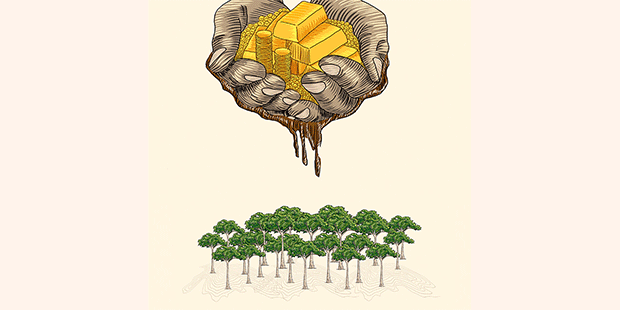I cannot see images of mining in Madre de Dios, writes Ernesto Raez Luna, without feeling physically sick. Gold is an obsession for this environmentalist and writer, but not for the same reasons as those in his native Peru who mine it, those pilgrims of the yellow king. The ravages gold inflicts on the trees and the rivers, the ravages it exacts on the men, the women, the teenaged children who follow its path into the Andean foothills at the headwaters of the Amazon: what skyrocketing gold prices on Western commodity exchanges have wrought.
I once held a heavy gold coin in the palm of my hand. When I raised my head I realized that everyone around me — good people for the most part — were looking at my hand with unabashed excitement, as if under a spell. Gold simultaneously symbolizes the most sublime and the greatest evil.
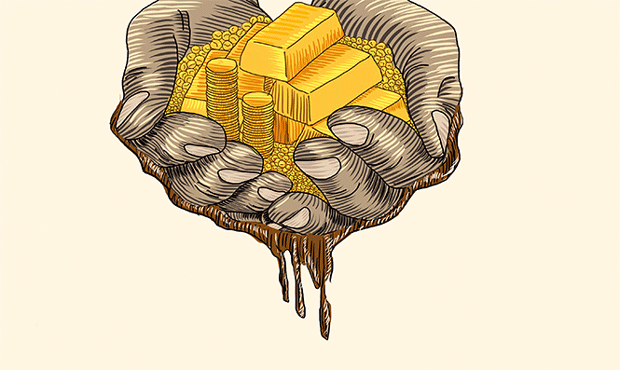
Moses smashed the Stone Tablets when he found people worshipping the Golden Calf, but a few thousand years later there is not a Judeo-Christian society that does not worship gold. Gothic artists painted the sky gold. The treasure chests of all the churches are overflowing with gold. For centuries, entire civilizations have offered gold to their leaders and gods and have stockpiled it as a testimony to their wealth. To mine it, millions of people have been enslaved, but many others have gone to great lengths to voluntarily search it out. Countless injustices and murders have been committed to separate the golden metal from its rightful owners. I am immune to gold and I do not understand it. Maybe I have seen too much of where it comes from and where it goes.
I went to the city of Puerto Maldonado for the first time almost thirty years ago, towards the end of the last gold fever that preceded the one we have entered now. The capital of the Amazonian province of Madre de Dios, nestled deep in the planet’s most diverse jungle, in those days it was a large, impeccably deforested swath of wide, solitary avenues.
Decades later, one afternoon in 2010 in Puerto Maldonado, when I had already spent a few years publishing stories warning about the evils of the new mineral boom that was laying waste to rivers and forests in Madre de Dios, an ex-farmers’ union leader who I had faced off with in the past came to see me. Stocky and abrupt like a bull, he asked if he could talk to me. He appeared anxious and impatient. We found a discrete place, sat down, and before I knew it the man loosed in a torrent all that was asphyxiating him.
He had gotten into illegal mining in Madre de Dios and needed to talk about it. I have a faint, painful memory of his story: “When you get there they take away your driver’s license,” he told me, “We work in the mud from sunrise until dark. They arrive in trucks with booze and girls. Sometimes they are very young, 12, 13 years old, tight, young, fresh meat!”
His eyes were shining. Fresh meat. “And we all drink until we’re wasted. And you’re with the girls and who knows what might happen, all kinds of things, and the next day it’s the same. They put you in debt with booze and whores. I couldn’t take it.” He stopped all the sudden and we sat in silence. He stood up and left. We did not make an effort to see each other again.
A year later, towards the end of 2011, the minister of environmental protection asked me to represent the sector in the government’s offensive on illegal mining, which was already affecting 21 of the country’s 24 regions, including Lima.
On one of the many useless days in the wing of the government palace that houses the presidential council, and where we carried out never-ending discussions with miners that fell on deaf ears, I challenged one of the leaders of the Mining Federation of Madre de Dios (FEDEMIN): “At least get rid of the brothels with young girls that you have in your camps!” I said. The man, dying of laughter, responded: “I don’t have prostitutes in my camps. We go to Puerto Maldonado for that.”
Four years have gone by since the last time I entered a mining camp. It was in what they call the Guacamayo valley, a few hours from Puerto Maldonado. One ascends from the highway on the back of a motorcycle and zooms over boards that form precarious bridges, deep into the forest. It recalls the scene in Star Wars when Luke and Leia weave on their hovercrafts through tree trunks in the forest. But this was a sick forest, slashed down, dismembered.
Suddenly there was no vegetation at all and we arrived to what was once a creek. All that remained of the creek bed were two large conical pits where men worked in the mud among loud, rusty motors and thick hoses that looked like boas laying belly up.
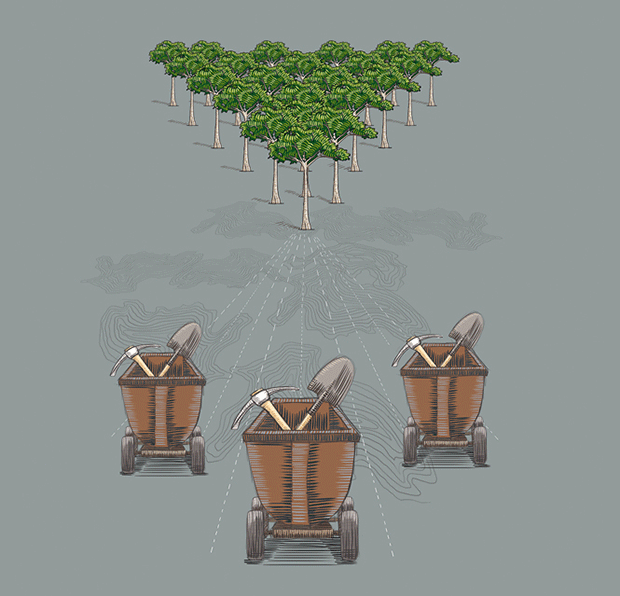
It was like traveling to a different country in an instant. Like waking unexpectedly, in broad daylight, in a hell painted by Bosch.
The mining settlement was two parallel rows of shacks covered in blue tarps for walls, giving the mud between them the illusion of a street in the desert, one that wound along the shores of the dried up creek.
There was nothing more than shops and brothels and more brothels. Signs: “Showers / Beds / Girls 24 hours”. Pigs shitting in the street. Dirty, sleepy girls standing in makeshift doorways. There was a radio station and I introduced myself to the young disk jockey who read people’s personal messages in between bouts of shrill music.
He read my card, looked at me sternly and said: “I’ve read what you write.” I had spoken out about this abject form of mining in newspapers and magazines. “Yes,” I said, “I’m that son of a bitch.” We both laughed. Later I said: “Look at this street: This isn’t life. Am I right?”. “Yes,” he responded, serious.
Since the beginning of the 21st Century, we have been living through a new and seemingly unending gold fever. In the century’s first decade, owing to increased demand in emerging countries like Russia and India along with financial uncertainty, the price of gold multiplied six times.
In Peru and other tropical countries that are rich in gold, there have long been poor people who extract gold using old, manual methods: with pans and a little mercury on the shores of rivers; with picks and explosives in cavernous crawlspaces. Often times they are women and children.
In Peru’s General Mining Law, they added to this artisanal, subsistence mining another more important and lucrative activity they called ‘small mining’, in order to treat them as if they were the same thing. Following that, the government avoided both kinds of mining for decades. Successive governments proposed “formalizing” — registering and supervising — the artisanal and small miners.
But a lack of organization among the miners themselves, a dismantled government, and vested interests frustrated and continue to frustrate those attempts. When the price of gold rose into the clouds, people who at one time were honestly poor and had been quietly accumulating significant capital as small miners became millionaires without the government knowing.
What was once a desperate refuge from misery or a way to combat poverty or a path toward middle class turned into a very liquid society, full of the new rich and money launderers of ill gotten gains. Because gold, different from cocaine, is traded and transported freely; it is legal, very portable, and difficult to trace back to its origin.
The gap between the production reported by the Ministry of Mining and Energy and the exports registered by tax officials reveals the scope of the plunder of our heritage: Peru exports more than $2 billion of illegal gold annually, a quantity more than sufficient to derail even the best of intentions.
This is Peru’s largest illicit economy, much bigger than drug trafficking. It turns out that illegal gold, free from labor and environmental regulation, is very profitable.
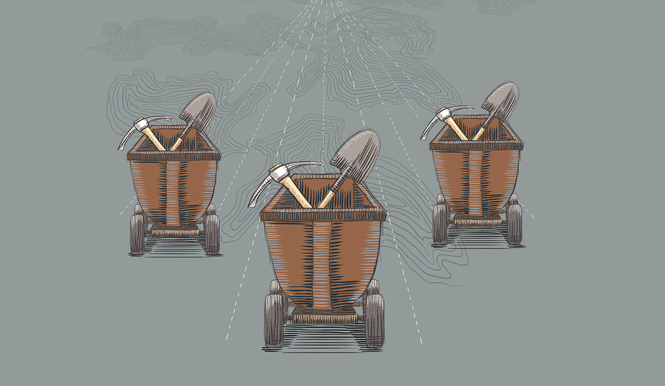
In 2012, when the government approved a raft of stern decrees against the trade of illegal gold, a black market blossomed immediately in Puerto Maldonado. In one of the roundtables they initiated to talk with the indignant miners, FEDEMIN president Luis Otsuka did some calculations out loud: “They buy from us at 80 soles a gram, when it’s worth 130. If I sell, I lose all my profit.”
In other words, if he had been able to sell his gold openly at market price, as was normal, then he would have had a 62 percent net profit. A report dated May 2014 by Macroconsult for the World Wildlife Fund concludes that the average profit for a small mining operation in Madre de Dios is almost 200,000 soles a year, with almost a 50 percent return on the investment. A large operation, on the other hand, has a net profit of almost five million soles, which can be up to three times the investment. Ironically, a large eco-tourism enterprise provides twice the number of jobs.
Up until five years ago, the government and Peruvian people knew so little about small and artisanal miners that when illegal mining appeared, like a snake from an egg, it was thought of as a kind of lower class horde, with labor unions and their corresponding federations.
In fact, the term ‘informal mining’ was coined to set them apart from the large mining coops. ‘Informal’ is used for any activity that violates all labor laws, contracts, tax code, environmental regulations, and several fundamental rights.
In Peru, it is estimated that more than half the economy works this way. ‘Informal’ is the preferred euphemism to distract people’s conscience. In Lima, people think of illegal miners as “covered in the uniform color of indifferent filth”, to borrow the words of (Peruvian poet) Martin Adan. As a result, the riots that occurred each time the government tried to impose a little order on the activity were dealt with in the same way as all popular protests: with expensive, bureaucratic roundtables and meetings overseen by government ministers.
It has taken two different governments to begin to understand that illegal mining has a complex structure that is determined in large part, and not innocently, by the government itself. Because of this, in Madre de Dios, FEDEMIN represents the mining bosses, unlawfully exploiting concessions awarded by the government.
These people are the bourgeoisie, not proletariat class. The lands ceded are worked by thousands of operators who work for foreman, colloquially called “invitados”, who pay part of their production to the concessionaires. The poor people who work, meanwhile, break their backs and die in frequent landslides, working under conditions of semi-forced labor.
Since there are no contracts, the concessionaires can declare little or no production. They can even report the foremen for trespassing. The mining concessions, initially slated for small and artisanal mining operations, function without permits but with million-dollar budgets. Typically, they have been ceded without taking into account the rights of others who live on the same land.
Because of this, in 2011 in Madre de Dios there were entire native communities whose lands were ceded to strangers. There were even dozens of reforestation concessions (to replenish the forest) that overlapped with mining concessions (which eradicate the forest because there is no other way to get at the gold underground).
The overlapping land use rights along with the precarious labor situation of mining’s proletariat mass are the two main reasons it is almost impossible to formalize most illegal mining operations. The mining sector and its concessionaires are complicit in superimposing land use and making it difficult to resolve conflicts and preventing contracts with benefits and protections for the multitude of workers.
There are an excess of villains in the business, but the large majority are miners who are victimized by the worst forms of exclusion and dehumanization. They are cannon fodder when it is good for the bosses, but they have no voice. They are shadows in the mud, a tattered mass of sweat and broken dreams. Many of them are still teenagers.
In September 2013, a few days after assuming his post as the high commissioner against illegal mining, Daniel Urresti, a general in the Peruvian Army, headed the police intervention in Madre de Dios, in a region where illegal mining is advancing on the Tambopata National Reserve, perhaps the most biologically diverse wilderness area on the planet.
Urresti, an energetic soldier, was not familiar with the region he would be overseeing and went to see what it was all about. He returned horrified by what he had seen, with his hand in a sling. When he jumped out of the helicopter, like Robert Duvall in Apocalypse Now, he slipped on “lama”, the slippery leeched clay that miners leave where there was once green forest. Getting out in front of the joke, Urresti himself went around saying that when he went back to make a report to President Ollanta Humala, his colleague said: “You’ve been on the job a week and they already broke your hand?” To break your hand means to take bribes in Peru.
Everyone in the government, at least since 2012, has been fully aware of the power illegal gold has to corrupt. In Peru, all three government branches have been infiltrated on all levels by the interests of illegal mining.
Besides numerous local authorities openly dedicated to defending this kind of mining, the president of the Supreme Court in Madre de Dios, Juan Hurtado Centeno, was suspended from his post and the court was raided because video surfaced showing him escorting personnel and yelling orders at an illegal gold mine, during office hours.
The executive director of hydrocarbons for the energy and mining ministry, Luis Vicente Zavaleta Vargas, turned out to be the owner of Universal Metal Trading SAC, which in 2011 exported 19 tons of gold — presumably from the infected pits of Madre de Dios — worth than $900 million. Forced into retirement, they thanked him for his service.
Notable people from the creole elite and major political forces have been involved in ‘informal’ mining. Eduardo Salhuana, the minister of justice for former-president Alejandro Toledo, was for the past three years a top adviser to FEDEMIN, an organization that gathers miners in a constant process of formalizing. Today, Salhuana manages Madre de Dios’ regional government.
Congressman Amado Romero — known by the press as ‘Comeoro’, or ‘Goldeater’ —, who was elected as candidate for the current government, oversaw FEDEMIN and got a six-month suspension for favoring irregular operations linked to his union.
Nestor Valqui, a member of parliament representing the Fujimori party, was recorded offering help to miners in the Labyrinth — in Madre de Dios — against the interdiction of the government while he was president of the commission on the environment and ecology.
A Fujimori party congressman, Francisco Cama Layme, accumulated 10 accusations in 2011 for mining contamination in Puno.
Aprista congressman Tomas Cenzano, also of Puno, was the co-owner of two mining operations that he passed on to family members. One of his companies was accused of owing 240 million soles in taxes. Salhuana and the most recent president of FEDEMIN, Luis Otsuka, now governor of Madre de Dios, recently took a selfie with the famous economist Hernando de Soto, who has been photographed — hold your fists high, comrades — with mining leaders from the south.
In the coalition formed by De Soto to formalize miners is the president of the Peruvian Society of Gastronomy, Bernardo Roca Rey. In August of 2011, the president himself and his wife, in an official visit to his home state of Ayacucho, oversaw a ceremony wearing vests for the mining association of Luicho, illegal miners who have flouted a Supreme Court order to be shut down because there are 2,000 of them and they control the top of a mountain.
Attempting to clear them out, according to the police, would result in a bloodbath. Mining leader Victor Chanduvi recently denounced presidential campaign contributions, something that has been denied by officials sources. But a 2010 picture taken by the president’s wife, Nadine Heredia, shows the then-presidential candidate hugging two miners who now accuse him of betraying them.
A little over a year ago, I did a flyover of the widespread destruction with Dr. Greg Asner from the Carnegie Institute, and the journalist Guido Lombardi. Since then, I cannot see images of mining in Madre de Dios without feeling physically sick. It is not the 50,000 hectares of poisonous sand that was recently the most diverse forest on the planet that affects me. It is the trees that teem at the border of that desert. No one has counted them yet: hundreds of upright trunks, ashen, with that air of eternal dignity that only a tree can have, perfectly dead. Blind, mute, accusing. I cannot look at them.
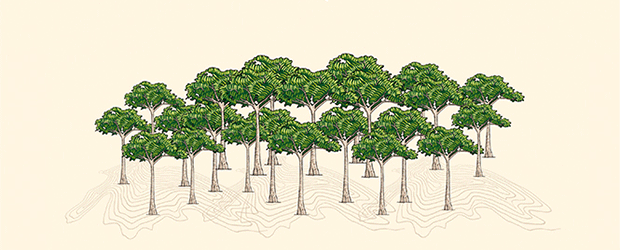
The waters of Madre de Dios run with asphyxiating lime and stratospheric levels of heavy metals. The children of Madre de Dios, the indigenous children, have levels of mercury — and probably lead and arsenic — up to five times above healthy levels. Many of them will have learning disabilities for the rest of their lives.
For generations to come, tens of thousands of people will suffer the consequences of this mining. But — different from Ecuador and Colombia, for example — the Peruvian government has completely given in to the mining lobby. There are two approved strategies: one of them comprehensive, and the other focused on the prosecution of criminals linked to gold, since no one reports them anymore. Government officials are debilitated, tired, bloated, on their way out. All they have to do is bide their time for a while and wait for the next government to take care of it.
*The Spanish version of this article was published last year, and some political figures mentioned have since left office.
Ernesto Ráez Luna Translated from Spanish by Brian Hagenbuch for International Boulevard.
14 Sep 2016




































